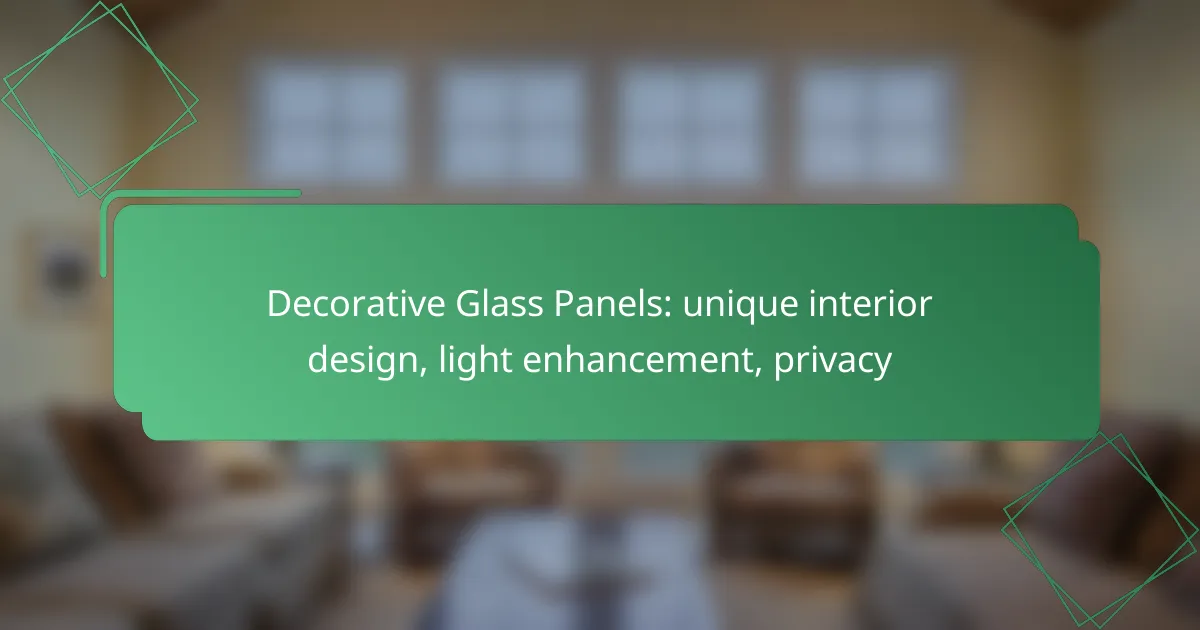Decorative glass panels are a versatile addition to interior design, offering a unique blend of aesthetic appeal and functionality. They enhance natural light flow while providing privacy, making them ideal for various spaces. Available in styles such as frosted, stained, and etched, these panels can transform any environment into a visually striking and inviting area.

How can decorative glass panels enhance interior design in Canada?
Decorative glass panels can significantly enhance interior design in Canada by adding visual interest, improving natural light flow, and providing privacy. These panels serve as versatile design elements that can transform spaces while catering to both aesthetic and functional needs.
Visual appeal and aesthetics
Decorative glass panels are available in various styles, colors, and textures, allowing homeowners to create unique focal points in their interiors. Whether used as room dividers or accent pieces, these panels can complement existing decor and elevate the overall ambiance of a space.
For instance, frosted or etched glass can add a sophisticated touch to bathrooms or office spaces, while colorful stained glass can serve as a vibrant centerpiece in living areas. Choosing the right design can enhance the character of a room and reflect personal style.
Natural light enhancement
One of the primary benefits of decorative glass panels is their ability to enhance natural light within a space. By strategically placing these panels, homeowners can maximize sunlight penetration, creating a brighter and more inviting environment.
For example, using clear or translucent glass in interior walls can help distribute light evenly throughout a room, reducing the need for artificial lighting during the day. This not only improves energy efficiency but also contributes to a healthier living space.
Customization options
Decorative glass panels offer extensive customization options to suit individual preferences and design requirements. Homeowners can choose from various thicknesses, finishes, and patterns to create a personalized look that fits their vision.
Additionally, many manufacturers in Canada provide bespoke solutions, allowing clients to specify dimensions and designs that align with their specific interior layouts. This level of customization ensures that each installation is unique and tailored to the homeowner’s needs.

What types of decorative glass panels are available?
Decorative glass panels come in various styles, each offering unique aesthetic and functional benefits. The most common types include frosted, stained, and etched glass panels, which can enhance interior design, improve light diffusion, and provide privacy.
Frosted glass panels
Frosted glass panels are created by sandblasting or acid etching clear glass, resulting in a translucent finish that diffuses light while obscuring visibility. This type of glass is ideal for spaces where privacy is desired, such as bathrooms or office partitions.
When choosing frosted glass, consider the level of opacity you need. Options range from light frosting, which allows some visibility, to heavy frosting, which offers complete privacy. Installation can be straightforward, but ensure proper sealing to prevent moisture buildup in humid areas.
Stained glass panels
Stained glass panels are made by combining colored glass pieces, often held together by lead came or copper foil. These panels can serve as striking focal points in a room, allowing colored light to filter through and create vibrant effects.
When selecting stained glass, think about the design and color scheme of your space. Custom designs can be expensive, but pre-made options are available at various price points. Maintenance involves regular cleaning to keep the glass clear and vibrant.
Etched glass panels
Etched glass panels feature designs that are carved into the surface of the glass, providing a more detailed and artistic appearance compared to frosted glass. This technique allows for intricate patterns and can be customized to suit specific design themes.
Consider the thickness of the glass and the complexity of the etching when choosing etched panels. They can be used in various applications, from shower doors to decorative room dividers. Regular cleaning is essential to maintain the clarity of the etched designs.

How do decorative glass panels provide privacy?
Decorative glass panels enhance privacy by obscuring visibility while allowing light to filter through. This balance makes them ideal for spaces where natural light is desired without compromising personal space.
Frosted glass for obscured views
Frosted glass is a popular choice for enhancing privacy as it diffuses light and obscures clear views. It is often used in bathrooms, office partitions, and entryways to maintain a sense of openness while preventing direct sightlines.
When selecting frosted glass, consider the level of opacity required. Options range from lightly frosted for partial obscurity to heavily frosted for maximum privacy. Installation can be straightforward, typically involving framing or adhesive mounting.
Textured glass for added privacy
Textured glass offers a unique aesthetic while providing privacy through its varied surface patterns. This type of glass can include designs such as ripples, waves, or geometric shapes, which scatter light and obscure visibility effectively.
Textured glass is suitable for both interior and exterior applications, such as shower doors and windows. When choosing textured glass, think about how the pattern will complement your overall design and whether it meets your privacy needs. Regular cleaning is essential to maintain its appearance and functionality.

What are the benefits of using decorative glass panels in residential spaces?
Decorative glass panels offer numerous advantages for residential interiors, including aesthetic appeal, enhanced natural light, and improved privacy. These features make them a popular choice for homeowners looking to elevate their living spaces.
Space enhancement
Decorative glass panels can visually expand a room by creating an illusion of openness. By allowing light to flow through while still providing a sense of separation, they help maintain a spacious feel in areas like living rooms or hallways.
Consider using frosted or etched glass for areas where you want to define spaces without sacrificing light. This approach works well in open-concept homes, where clear boundaries can enhance the overall design without making the area feel cramped.
Energy efficiency
Incorporating decorative glass panels can contribute to energy efficiency by maximizing natural light, reducing the need for artificial lighting during the day. This can lead to lower electricity bills, especially in regions with high energy costs.
Look for panels with energy-efficient coatings or double glazing to improve insulation. These features can help maintain comfortable indoor temperatures, reducing reliance on heating and cooling systems throughout the year.
Noise reduction
Decorative glass panels can also aid in noise reduction, making them ideal for homes located in busy urban areas. The thickness and type of glass used can significantly impact sound insulation, helping to create a more peaceful living environment.
When selecting panels for noise reduction, consider laminated or thicker glass options, as they are more effective at blocking sound. This can be particularly beneficial for bedrooms or home offices, where tranquility is essential for productivity and relaxation.

What factors should be considered when choosing decorative glass panels?
When selecting decorative glass panels, consider factors such as style compatibility, durability, and maintenance requirements. These elements will influence not only the aesthetic appeal but also the functionality and longevity of the panels in your space.
Style and design compatibility
Ensure that the decorative glass panels you choose align with the overall style of your interior design. Whether your space is modern, traditional, or eclectic, the glass panels should complement existing decor elements such as furniture, colors, and textures.
For example, frosted or etched glass panels may suit a contemporary setting, while stained glass can enhance a more classic or vintage look. Consider the scale and proportion of the panels in relation to the surrounding space to maintain visual harmony.
Durability and maintenance
Durability is crucial when selecting decorative glass panels, especially in high-traffic areas. Look for glass that is tempered or laminated, as these options provide increased strength and safety, reducing the risk of breakage.
Maintenance is another important consideration. Some glass types may require regular cleaning to maintain their appearance, while others, like textured or patterned glass, may hide smudges better. Evaluate your willingness to perform upkeep and choose accordingly to ensure long-lasting beauty and functionality.

How do decorative glass panels compare to traditional walls?
Decorative glass panels offer a modern alternative to traditional walls by enhancing light flow and providing unique design opportunities. Unlike solid walls, these panels can create a sense of openness while maintaining privacy, making them ideal for various interior spaces.
Light transmission
One of the primary advantages of decorative glass panels is their ability to transmit natural light. This feature can significantly brighten a room, reducing the need for artificial lighting during the day. Depending on the type of glass used, light transmission can vary, with options ranging from translucent to fully transparent.
When selecting glass panels, consider factors such as thickness and finish, as these can impact how much light is filtered. For example, frosted glass allows light to pass through while obscuring visibility, making it suitable for areas where privacy is essential.
Design flexibility
Decorative glass panels provide extensive design flexibility, allowing homeowners and designers to customize spaces creatively. They come in various styles, colors, and textures, enabling seamless integration into different interior themes, from contemporary to traditional.
Additionally, glass panels can be used in various applications, such as room dividers, shower enclosures, or even as artistic wall features. When planning your design, think about how the glass will complement existing elements in the room, such as furniture and color schemes, to create a cohesive look.

What are the installation options for decorative glass panels?
Decorative glass panels can be installed in various ways, depending on the intended use and design preferences. Common installation options include framed, frameless, and sliding systems, each offering unique aesthetic and functional benefits.
Framed Installation
Framed installations involve placing decorative glass panels within a supportive frame, which can be made from materials like wood, metal, or PVC. This method provides added stability and can enhance the overall design by allowing for a variety of frame styles and finishes.
When considering framed installations, ensure that the frame complements the interior decor. Additionally, check for compatibility with local building codes, especially if the panels are used in areas like bathrooms or kitchens where moisture is a concern.
Frameless Installation
Frameless installations create a sleek, modern look by securing decorative glass panels directly to walls or ceilings without visible frames. This option maximizes light flow and provides an unobstructed view, making it ideal for spaces where aesthetics are paramount.
For frameless installations, use high-quality adhesive or clamps to ensure stability. It’s essential to consult with a professional installer to guarantee proper support and alignment, especially for larger panels.
Sliding Systems
Sliding systems allow decorative glass panels to move along a track, providing flexibility in space usage. This option is particularly useful for room dividers or closet doors, where the ability to open and close the panels can optimize space and functionality.
When choosing sliding systems, consider the weight of the glass and the quality of the track. Ensure that the system can support the panel’s weight and operates smoothly to avoid common issues like jamming or misalignment.










